Haw can I draw a circle like this in VB.NET or in C#?
Asked
Active
Viewed 602 times
-4
Eugen Hübner
- 211
- 3
- 12
-
1It would be awesome if you could share a [mcve] of your progress so far. – mjwills Jan 17 '20 at 12:14
-
1The simplest solution is likely to screenshot the image, save it to a bitmap and then add that bitmap to your form. – mjwills Jan 17 '20 at 12:14
-
5Where do you want to "draw" this? On a form? Into a bitmap? In OpenGL? By sending position and colors to a network of drones to draw it in the sky? – Longoon12000 Jan 17 '20 at 12:15
-
1decide for one of the languages, make a loop from zero to 2π, compute x coordinate as radius * cos(angle) and y coordinate as radius * sin(angle). create a suitably thick solidcolor brush and assign the color using some Color.FromArgb(...) where the arguments are a function of the angle. – Cee McSharpface Jan 17 '20 at 12:52
-
@CeeMcSharpface I don't think you get there with RGB colors, have to use the Hue from the HSV color space. HSV-to-RGB-translation is not trivial, but is of course also googleable. – KekuSemau Jan 17 '20 at 13:04
-
1yeah [whatever floats your boat](https://stackoverflow.com/a/6930407/1132334) – Cee McSharpface Jan 17 '20 at 13:05
-
Try filling a GraphicsPath with a [PathGradientBrush](https://learn.microsoft.com/en-us/dotnet/api/system.drawing.drawing2d.pathgradientbrush?view=netframework-4.8) - [Example](https://stackoverflow.com/questions/33415696/n-point-gradient-brush-polygon-fill/33424456#33424456) – TaW Jan 17 '20 at 14:56
1 Answers
3
You can approximate the ring with lots of trapezoids, and use a different fill colour for each rectangle.
Imports System.Drawing.Drawing2D
Public Class Form1
Private Sub Form1_Paint(sender As Object, e As PaintEventArgs) Handles MyBase.Paint
Dim centre = New PointF(160, 140)
Dim r1 = 100
Dim r2 = 105
Dim colourStart = 90 * Math.PI / 180
Dim col1 As Color
col1 = Color.FromArgb(0, 0, 0)
e.Graphics.SmoothingMode = SmoothingMode.AntiAlias
Using br As New SolidBrush(col1)
Dim nSteps = 180
Dim aInc = 2 * Math.PI / nSteps
For i = 0 To nSteps - 1
Dim a = i * aInc
Dim t1 = a
Dim t2 = a + aInc
Dim p1 = New PointF(CSng(r2 * Math.Cos(t1)) + centre.X, CSng(r2 * Math.Sin(t1)) + centre.Y)
Dim p2 = New PointF(CSng(r1 * Math.Cos(t1)) + centre.X, CSng(r1 * Math.Sin(t1)) + centre.Y)
Dim p3 = New PointF(CSng(r1 * Math.Cos(t2)) + centre.X, CSng(r1 * Math.Sin(t2)) + centre.Y)
Dim p4 = New PointF(CSng(r2 * Math.Cos(t2)) + centre.X, CSng(r2 * Math.Sin(t2)) + centre.Y)
Dim pts = {p1, p2, p3, p4}
col1 = HSL2RGB(a + colourStart, 1, 0.5)
br.Color = col1
e.Graphics.FillPolygon(br, pts)
Next
End Using
End Sub
' HSL2RGB from https://dotnetfiddle.net/aORkec (with translation and bugfix).
''' <summary>
''' Convert HSL to RGB.
''' </summary>
''' <param name="h">Hue 0..2pi</param>
''' <param name="s">Saturation 0..1</param>
''' <param name="l">Lightness 0..1</param>
''' <returns>RGB color.</returns>
<DebuggerHidden>
Function HSL2RGB(h As Double, s As Double, l As Double) As Color
If h > 2 * Math.PI Then h -= 2 * Math.PI
If h < 0 Then h += 2 * Math.PI
h = h / (2 * Math.PI)
Dim v As Double
Dim r, g, b As Double
r = l
g = l
b = l
v = If(l <= 0.5, l * (1.0 + s), l + s - l * s)
If (v > 0) Then
Dim m As Double
Dim sv As Double
Dim sextant As Integer
Dim fract, vsf, mid1, mid2 As Double
m = l + l - v
sv = (v - m) / v
h *= 6.0
sextant = CInt(Math.Floor(h))
fract = h - sextant
vsf = v * sv * fract
mid1 = m + vsf
mid2 = v - vsf
Select Case sextant
Case 0, 6
r = v
g = mid1
b = m
Case 1
r = mid2
g = v
b = m
Case 2
r = m
g = v
b = mid1
Case 3
r = m
g = mid2
b = v
Case 4
r = mid1
g = m
b = v
Case 5
r = v
g = m
b = mid2
End Select
End If
Return Color.FromArgb(Convert.ToByte(r * 255.0F), Convert.ToByte(g * 255.0F), Convert.ToByte(b * 255.0F))
End Function
End Class
Result:
Better results could probably be achieved by using a Brush which allows a colour gradient in the correct direction for each rectangle.
It is also possible to make the circle from annular sectors, which gives accurate bounds instead of the straight edges of trapezoids:
Function Rad2Deg(x As Double) As Single
Return Convert.ToSingle(x * 180 / Math.PI)
End Function
Private Sub Form1_Paint(sender As Object, e As PaintEventArgs) Handles MyBase.Paint
Dim centreF = New PointF(160, 140)
Dim centre = New Point(CInt(centreF.X), CInt(centreF.Y))
Dim r1 = 100
Dim r2 = 105
Dim boundingRectInner = New Rectangle(-r1, -r1, r1 * 2, r1 * 2)
boundingRectInner.Offset(centre)
Dim boundingrectOuter = New Rectangle(-r2, -r2, r2 * 2, r2 * 2)
boundingrectOuter.Offset(centre)
Dim colourStart = 90 * Math.PI / 180
Dim col1 As Color
col1 = Color.FromArgb(0, 0, 0)
e.Graphics.SmoothingMode = SmoothingMode.AntiAlias
Using br As New SolidBrush(col1)
Dim nSteps = 12
Dim aInc = 2 * Math.PI / nSteps
Dim sweepAngle = Rad2Deg(aInc)
For i = 0 To nSteps - 1
Dim a = i * aInc
Dim t1 = a
Dim t2 = a + aInc
Dim p3 = New PointF(CSng(r1 * Math.Cos(t2)) + centreF.X, CSng(r1 * Math.Sin(t2)) + centreF.Y)
Dim p4 = New PointF(CSng(r2 * Math.Cos(t2)) + centreF.X, CSng(r2 * Math.Sin(t2)) + centreF.Y)
Using gp As New GraphicsPath()
gp.AddArc(boundingRectInner, Rad2Deg(a), sweepAngle)
gp.AddLine(p3, p4)
gp.AddArc(boundingrectOuter, Rad2Deg(a + aInc), -sweepAngle)
gp.CloseFigure()
col1 = HSL2RGB(a + colourStart, 1, 0.5)
br.Color = col1
e.Graphics.FillPath(br, gp)
End Using
Next
End Using
End Sub
Note the smaller number of steps, so the colours are fewer, yet the edges are still those of a circle:
Andrew Morton
- 24,203
- 9
- 60
- 84


